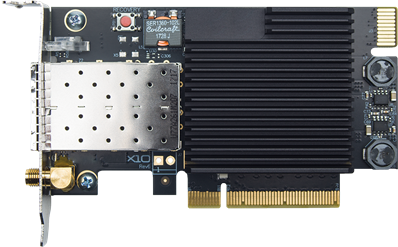Cisco Nexus K35-S FPGA SmartNIC Data Sheet
Available Languages
Bias-Free Language
The documentation set for this product strives to use bias-free language. For the purposes of this documentation set, bias-free is defined as language that does not imply discrimination based on age, disability, gender, racial identity, ethnic identity, sexual orientation, socioeconomic status, and intersectionality. Exceptions may be present in the documentation due to language that is hardcoded in the user interfaces of the product software, language used based on RFP documentation, or language that is used by a referenced third-party product. Learn more about how Cisco is using Inclusive Language.
Ultra-low latency network interface card
The Cisco Nexus K35-S FPGA SmartNIC is a 10Gbps PCI Express network interface card specifically optimized for low latency environments.
While initially conceived and built for use in latency-sensitive financial applications such as high-frequency trading, the Cisco Nexus K35-S FPGA SmartNIC has appeal that extends to any environment where latency is key. On an Intel® Ivy Bridge test system, median latency from application to network to application is 780 nanoseconds for small packets, which is significantly better than competing network cards on the same hardware. Half-roundtrip TCP latencies are as low as 930 nanoseconds for small payloads.
In addition to a standard Linux driver, a transparent TCP and UDP acceleration library is included, as well as a library for low-level access.
A transparent socket acceleration library allows applications to benefit from the low latency of a kernel bypass, in most cases without modifications to the applications. For the most latency-sensitive applications, a library called “libexanic” allows direct low-level access to the Cisco Nexus K35-S FPGA SmartNIC hardware and includes simple functions for sending and receiving Ethernet frames. With the optional firmware development kit, it is even possible to extend the Cisco Nexus K35-S FPGA SmartNIC firmware and add your own logic to the onboard FPGA.
Advanced capture and timestamping
Built-in timestamping functionality records each frame’s arrival time to within 6.2ns.
These timestamps are available through a direct API and through Exact Capture, our free and open-source, high-rate capture system. Exact Capture can write tcpdump-compatible captures at line-rates to disk.
Additionally, the Cisco Nexus K35-S FPGA SmartNIC has Pulse-Per-Second (PPS) input and output and supports hardware-accelerated PTP. These can be used to synchronize the ExaNIC clock to external time references (such as a GPS receivers) allowing users to meaningfully compare captured timestamps across multiple servers and geographic locations. Finally, flow steering can be used to deliver packets to the right application’s receive buffer, while flow hashing can be used to distribute packets across multiple CPU cores for demanding capture applications.
The Cisco Nexus K35-S FPGA SmartNIC includes integrated support for bridging, which can further reduce latency by hundreds of nanoseconds.
Normally, sharing an upstream connection between multiple servers would necessitate introducing a switch. The bridging feature allows the most latency-critical server to be directly connected to the upstream connection.
Packets not destined for the local server can be bridged to the second port, transparently and with low latency. This port could be connected to a backup server or to a downstream switch.

Cisco Nexus K35-S FPGA SmartNIC
Performance
Typical latency, raw frames:1
● 64 bytes: 780 ns
● 256 bytes: 1 µs
Typical latency, raw frames with preloaded TX buffer:1
● 64 bytes: 710 ns
● 256 bytes: 930 ns
Typical latency, UDP:2
● 14 bytes: 880 ns
● 256 bytes: 1.2 µs
Typical Latency, TCP:2
● 14 bytes: 930 ns
● 256 bytes: 1.2 µs
Timestamping
Timestamp resolution:
● 6.2ns
Timestamp availability:
● All received frames, most recent transmitted frame
Time synchronization:
● Host, hardware assisted PTP, optional PPS
PPS input/output:
● 3.3V CMOS, selectable 50ohm termination
Other features
Bridging:
● Optional forwarding between ports 1 and 2, latency <110ns
Capture:
● Line-rate capture to disk
Flow steering:
● 128 IP rules per port
● 64 MAC rules per port
FPGA Development Kit:
● Add custom user logic to FPGA
● Xilinx Ultrascale XCKU035-2
● Fully integrated with drivers, utilities, and TCP/UDP stack
General
Form factor:
● Low-profile PCI Express Card
● 117x68mm (4.65x2.67in)
Environmental:
● Operating temperature: 0 °C to 55 °C
● Storage temperature: -40 °C to 70 °C
● Operating Relative Humidity: 5% to 90% (non-condensing)
● Storage Relative Humidity: 5% to 95% (non-condensing)
Ports:
● 2x SFP+
● SMA for PPS in/out
Data rates:
● 10GbE, 1GbE, 100M Fast Ethernet
Supported media:
● Fiber (10GBASE-SR, 10GBASE-LR, 1000BASE-SX), SFP+ Direct Attach
Host interface:
● PCIe x8 Gen 3 @ 8.0 GT/s per lane
Operating systems:
● Linux x86_64 (all distributions)
Footnotes
Cisco environmental sustainability
Information about Cisco’s environmental sustainability policies and initiatives for our products, solutions, operations, and extended operations or supply chain is provided in the “Environment Sustainability” section of Cisco’s Corporate Social Responsibility (CSR) Report.
Reference links to information about key environmental sustainability topics (mentioned in the “Environment Sustainability” section of the CSR Report) are provided in the following table:
| Sustainability topic |
Reference |
| Information on product material content laws and regulations |
|
| Information on electronic waste laws and regulations, including products, batteries, and packaging |
Cisco makes the packaging data available for informational purposes only. It may not reflect the most current legal developments, and Cisco does not represent, warrant, or guarantee that it is complete, accurate, or up to date. This information is subject to change without notice.
Flexible payment solutions to help you achieve your objectives
Cisco Capital® makes it easier to get the right technology to achieve your objectives, enable business transformation and help you stay competitive. We can help you reduce the total cost of ownership, conserve capital, and accelerate growth. In more than 100 countries, our flexible payment solutions can help you acquire hardware, software, services and complementary third-party equipment in easy, predictable payments. Learn more.